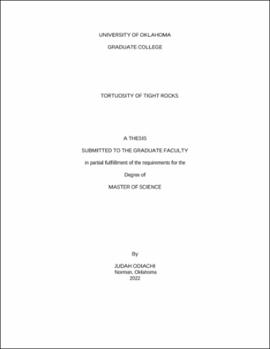| dc.description.abstract | Tortuosity is a rock property that controls transport processes in porous media. It is essential in advective, diffusive transport and flow of electric current, especially in tight rocks which are characterized by low porosity and low permeability such as unconventional shale reservoirs. However, experimental values of diffusional and electrical tortuosity of tight rocks are scarce in the literature. To improve the understanding of diffusive transport and electrical flow in unconventional tight rock reservoirs, I have measured and compared the diffusional and electrical tortuosities of 12 tight rock samples from Utica, Bakken, Wolfcamp, and Eagle Ford formations and 3 sandstones from Berea, Lyon and Illinois Basin.
For this study, the samples selected were characterized by measurements of total organic carbon (TOC), mineralogy, porosity, and pore size distributions using scanning electron microscopy image analysis, mercury injection capillary pressure, and subcritical nitrogen adsorption. Upon characterization, the samples were soxhlet-extracted with methanol and dried at 100°C before saturating with 25,000 ppm KCl brine. To measure diffusional tortuosity, the brine saturated samples were immersed into D2O to allow the diffusion of D2O into the samples. The rates at which D2O diffused into the samples were measured with 12 MHz NMR instruments. The effective pore fluid diffusion coefficient of D2O and the bulk diffusion coefficient of D2O were used to compute the diffusional tortuosities.
To measure the electrical tortuosities, the samples were resaturated with 25,000 ppm KCl brine before immersion into 60,000 ppm KCl brine. The measurements of the samples’ resistivities as a function of time after the immersion into the 60,000 ppm KCl brine were used to compute effective pore ionic diffusion coefficients. These effective pore ionic diffusion coefficients were used in combination with the ionic bulk diffusion coefficient to compute the electrical tortuosity of the samples.
Our measurements show that the diffusional tortuosity and electrical tortuosity have similar values. Therefore fluid diffusion and electrical conduction are controlled by the same flow path.
These tortuosities in the tight rock samples range between 1.8 to 5.8, while the sandstones range between 1.4 to 3.9.
A method to determine effective porosity was also developed and it was observed that the effective porosity in the tight rocks ranged between 45 - 93% of the total porosity, while the sandstones had effective porosities approximately equal to the total porosity.
For the unconventional tight rock samples studied, it is observed that TOC exerts a primary control on the diffusional and electrical tortuosity as well as effective porosity of tight rocks.
The observations made in this study indicate that electrical and diffusive flow are controlled by the same flow path. Therefore, electrical tortuosity from resistivity formation factor measurements can be used in place of diffusional tortuosities in huff-n-puff EOR design and optimization because the electrical tortuosity measurements can be performed in minutes while diffusional tortuosity measurements take weeks to complete. Also, the knowledge of electrical tortuosity is important in determining electrical parameters to accurately determine the water saturation. | en_US |
